#Photinus pyralis
Explore tagged Tumblr posts
Text


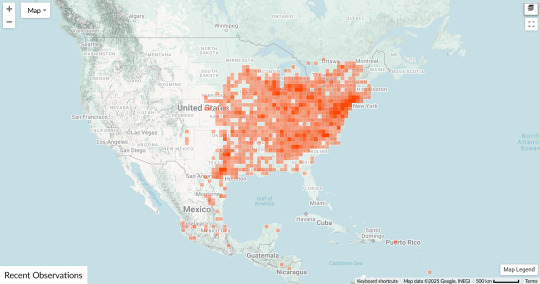
#poll#Class: Insecta#Order: Coleoptera#Family: Lampyridae#Genus: Photinus#Photinus Pyralis#Range: Nearctic#Range: Neotropical#bug tw#insect tw
140 notes
·
View notes
Text
Photinus pyralis, os vaga-lumes, cada vez mais raros.
#photinus pyralis#animales#animal#animals#biologia#biolgoy#insetos#invertebrados#invertebrates#insects
6 notes
·
View notes
Video
Common eastern firefly (Photinus pyralis) by Trey Wardlaw
#macro photography#macro#bug#insect#firefly#common eastern firefly#pyralis#Photinus#Photinus pyralis#flickr
0 notes
Text
Photinus fireflies are probably one of North America’s most iconic and beloved beetles, and rightfully so. P. pyralis is big and bright, with a yellow-green color to its bioluminescence

I also often see these smaller Photinus with a warm orange glow. I think they could be P. scintillans, which aligns with their size, flash pattern, the yellow sclerites on males, and where I’m located. females of that species are short-winged and flightless, so I’ll try to find one to figure out the ID for sure.
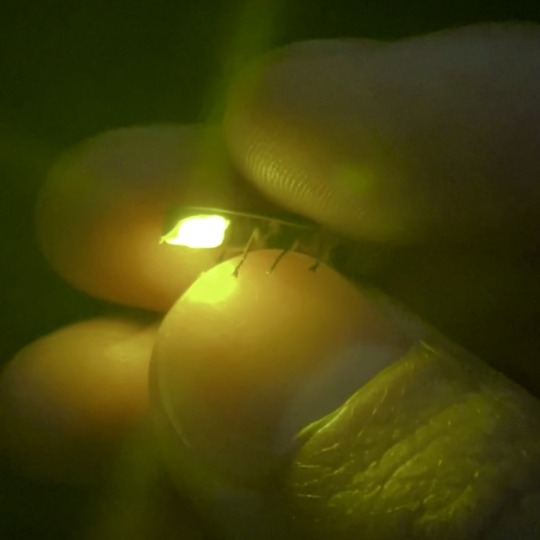
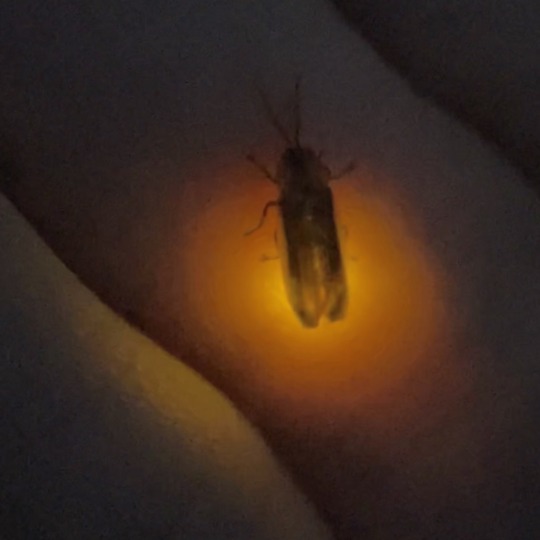
reminder that fireflies eat slugs and snails as larvae! if you like seeing them in your garden, stop trying to exterminate land gastropods and leave some vegetation where the adults can sleep during the day. slugs and “weeds” = more magic glowing bugs
10K notes
·
View notes
Text
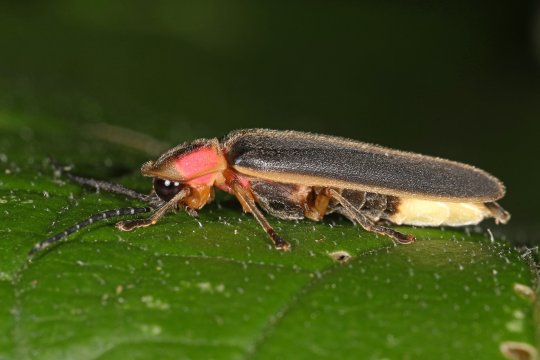
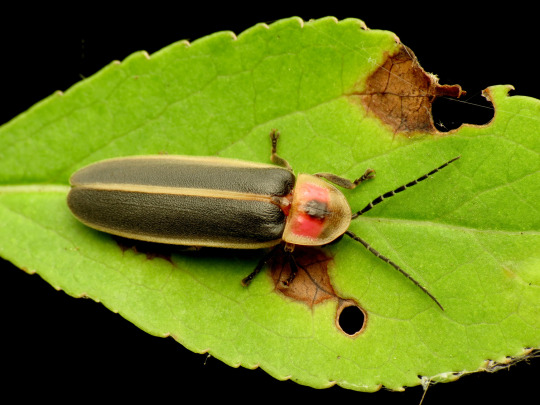
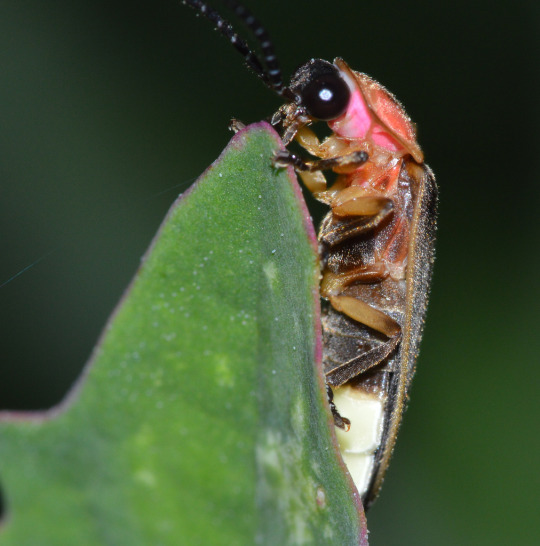
A Night Out with the Eastern Firefly
The eastern firefly, or North American firefly (Photinus pyralis), is a popular sight throughout the United States and southern Canada east of the Rocky Mountains. They are commonly associated with the beginning of summer, as they spend the winter hibernating underground and emerge only when the weather begins to warm. They are commonly seen in deciduous forests, grasslands, gardens, and backyards.
Contrary to their name, the eastern firefly is actually a type of beetle with well-developed wings. Adults are quite small, only 10-14 mm (0.39-0.55 in) long. They have a yellow and red head and a dark brown body with a narrow yellow stripe marking the outline of the wing casings. The main difference between the two sexes is the length of their wings; males have longer wings and are capable of flight, while females have shorter, less functional wings. Both sexes have a special organ on the end of their abdomens that produce light; however, the female's light tends to be weaker. The North American firefly produces its light by combining oxygen with a chemical called luciferin; the resulting chemical reaction gives off a glow which is amplified by special reflective cells in the firefly's abdomen.
Like all fireflies, P. pyralis uses its light producing ability to attract a mate. Males flash only while flying, in bursts about 6 seconds apart. Once a female signals her interest-- also by flashing-- the male lands near her and offers her a package called a spermatophore made of sperm, protein, and nutrients. If the female accepts, she inseminates herself and buries the rest of the package with her clutch of about 500 eggs. These eggs, which glow slightly during development, hatch about 4 weeks after being laid, and the larvae feed on the remains of the nutrient-rich spermatophore. The larvae can take one or two years to develop, and spend most of their time underground or near sources of fresh water like lakes and streams. Once the larva pupates and develops into an adult firefly, they only live in this stage for about a month before dying.
Both larva and adult eastern fireflies are predators, feeding on other insects like worms, snails, and other fireflies. However, larva spend almost all their time hunting for food, while adults spend the majority of their time seeking out a mate. To avoid predation, P. pyralis can emit foul-smelling odors and excretion of sticky substances; they also emit a chemical called lucibufagin that repells spiders. However, other species of fireflies will actually mimic the light patterns of the eastern firefly in order to predate upon them.
Conservation status: The North American firefly is currently considered Least Concern by the IUCN. However, they are threatened by light pollution, pesticides, and habitat loss.
Photos
Judy Gallagher
Katja Shultz
Sydney Penner via iNaturalist
#eastern firefly#north american firefly#Coleoptera#Lampyridae#rover fireflies#fireflies#beetles#insects#arthropods#deciduous forests#deciduous forest arthropods#grasslands#grassland arthropods#urban fauna#urban arthropods#animal facts#biology#zoology#ecology
147 notes
·
View notes
Note
Uh, I saw your post and you mentioned that you teach the kids... how do I put it... that are given to you at social functions due your park ranger aura for safekeeping how to tell the difference between predatory lightning bugs and normal lightning bugs.
And then you didn't tell us that secret! May I ask you to share the difference between predatory lightning bugs and normal ones?
Thank you very much :)
By popular demand and because this was the most polite ask: how to tell the predatory lightning bugs from the non-predatory lightning bugs.
First, there are over 2000 species in Lampyridea. I am not qualified to distinguish between all that. I grew up in Northern Ohio (71 species) and every year summer wasn’t official until the lightning bugs came out in the evenings (usually the first or second week of June).
This is our first clue. The first lightning bugs out each evening are a species of non-predatory chaps. Their glow goes in a special pattern. Flash, pause, “J” shaped flight about 2 -3’ off the ground. Repeat. Their glow is more yellow and lingers. These are the males of Photinus pyralis or the common eastern firefly. They look like this:

(Photo from iNaturalist: a lightning bug beetle, mostly black with gold lines around the wing casing. Head shield is yellow with a red “eye” with black iris in the center. Rounded front and back, long down the center.)
Their females hide in tall grasses waiting for the right suitor. If you’re lucky and clever you can see her dimmer flash in the grass beaconing the males closer.
As the dark of night progresses you’ll start to see a quicker, brighter, greener flash. Blip, blip, blip, blip, long pause. They are FAST! They’ll also mimic the flashes of Photinus females. These are usually higher up off the ground. Even in the trees! These lightning bugs aren’t looking for love.
Photuris (not gonna get to specific epitaph on this one without a sample and a key) are looking for dinner!
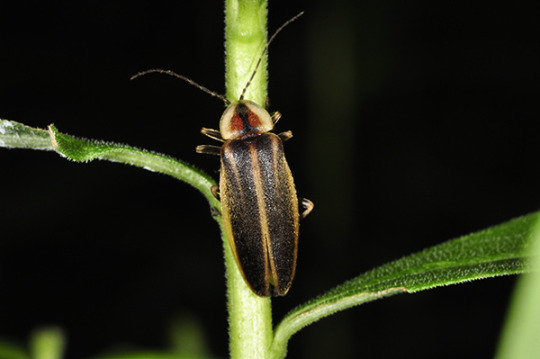
(Photo from blog.greatparks.org another lightning bug beetle. This one is slightly larger than the non-predatory bug. It has “shoulders” and extra gold lines running through the back. Its legs are longer and its shield is more “sharp”. The shield marking is less like an eye and more like a yellow D where the inside is a red triangle with a black line running through.)
Another way to tell is to go out at night and catch a bunch of lightning bugs (if you can; I hear they’re getting scarce). Offer them a slice of apple. If you wake up in the morning to only a few and the rest are dead, good chance you found some predators. (This is how I found out about them! Wooops!!)
Lightning bugs are freaking magical. I’m so sad to hear that they are yet another wonder that we are losing at an alarming rate. If this bugs you as much as it bugs me there are a few things you can do to help them:
1) do not spray for mosquitoes! That spray is not-species specific. It’s bad for lightning bugs. It’s bad for monarch butterflies. It’s bad for birds. It’s bad for bats. It’s bad.
2) kill your lawn. But Misha! You said they breed in the grasses! True! However native plants are going to provide so much more habitat for these guys than a gross monoculture of Kentucky bluegrass ever will. The Midwest has some of the best native plant nurseries in the country! Use that resource!
3) Advocate for them and donate to conservation if you’re able. Bugs don’t have voices and they fight an uphill battle just for being a bug.
Thanks for joining my ranger talk! Support your parks.
259 notes
·
View notes
Text
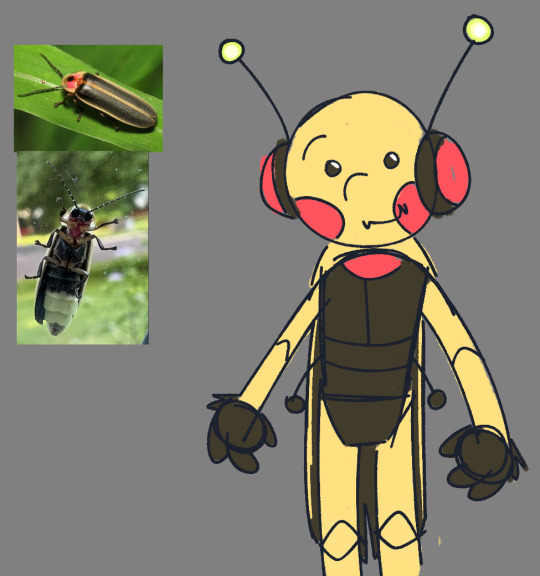
woudl you still love me if i was a Common Eastern Firefly (Photinus pyralis)
32 notes
·
View notes
Note
Bug girl! Favorite bug?
"OKAY, so I've always loved fireflies because my middle name is Pyralis, which means 'bug born from fire' or something like that, right? And there's a firefly species called Photinus Pyralis, which, by the way, fun fact; different firefly species have varying flash patterns to identify each other for mating and such! Photinus Pyralis, also known as the Big Dipper firefly for its J-shape flash pattern, is super cute! Like little stars, but on the ground! And I can hold them!
BUT THEN. I feel like this doesn't cover all the bugs I like. For the Hemiptera order, I'd say I love the Dog-Day cicada. It's a super pretty green, and I'm a pretty big green enthusiast. Aha. It feels super nostalgic to me, like... a long summer day while I stayed out in the sun when I was younger. They're pretty loud, but it's easy to identify them amongst other cicada calls! Ooh, and fun fact, their name is based on the brightest star in Canis Major, AKA Sirius! Represents that they come out during the hottest days of summer.
Don't even get me started on lepidopterans. Butterflies! Moths! They're sooooo cute! Listen, some people think they're kinda freaky because their faces are weird or whatever, but I think bug faces are ADORABLE! I mean, how could you not love their big ol eyes? Anyways. Oleander hawk moths are super pretty, I love hawk moths because they have such thin wings and they're still able to fly! In fact, they're really agile and quick and aerodynamic and super pretty and. Yeah. For butterflies... probably the malachite butterfly? They're green and pretty! But all butterflies are lovely. Reminds me of a nice spring day!
Gosh, I'm really rambling in this post... but I don't want to leave any bug out. I mean... there's so many bugs in the world! Much more than any humanoid or monster out there, I bet. They're all so cool... I really wish I could go on for longer. But hey, if you're curious about a certain bug order or something like that, feel free to ask!
TL;DR... I love all bugs. That's it. All bugs. But I guess fireflies take the top pick!"
#d&d#dungeons and dragons#d&d campaign#father's quest#father's quest campaign#d&d campaigns#vixen osier#vixen father's quest#bugs#insects#please ask me about bugs#please#PLEASE THEY'RE SO COOL
8 notes
·
View notes
Text

JuneBug: Celestial Firefly (Photinus pyralis)
45 notes
·
View notes
Text
hey i'm still alive guys. here's my newest fursona, Astra :3
(he/they)
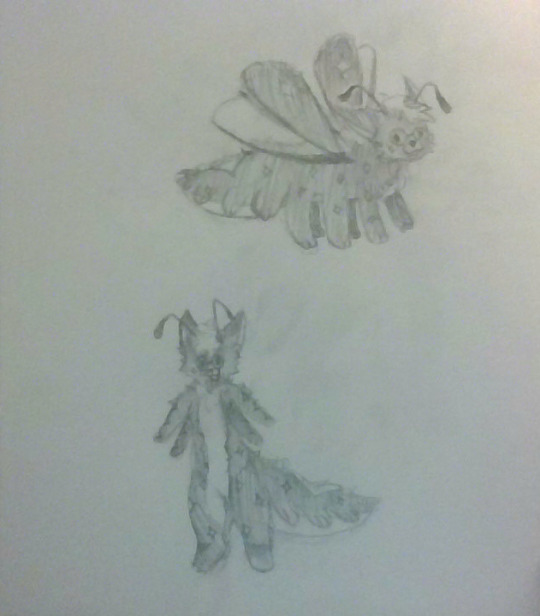
species: Pawpillar (Photinus pyralis firefly) defining features: fur pattern looks like stars. the 'white' patches are actually clear fur and they let the light through when he lights up! :3
(original species created by @bugdottpng, check out their blog pls :D their art style is so edible, i love it) DISCLAIMER: My art is prohibited from being used for AI. Do not steal, trace, or otherwise repost my art. For safety reasons, until AI can die off, do not add image descriptions to my posts.
sorry for the terrible image quality btw, my camera sucks rn lol
(also on the bottom image, I tried drawing wings but didn't like the way it looked so yea <(^-^)>
reblogs > likes! im trying to gain some traction here (but not too much pls cos i dont know how to deal with a lot of attention lol)
5 notes
·
View notes
Text

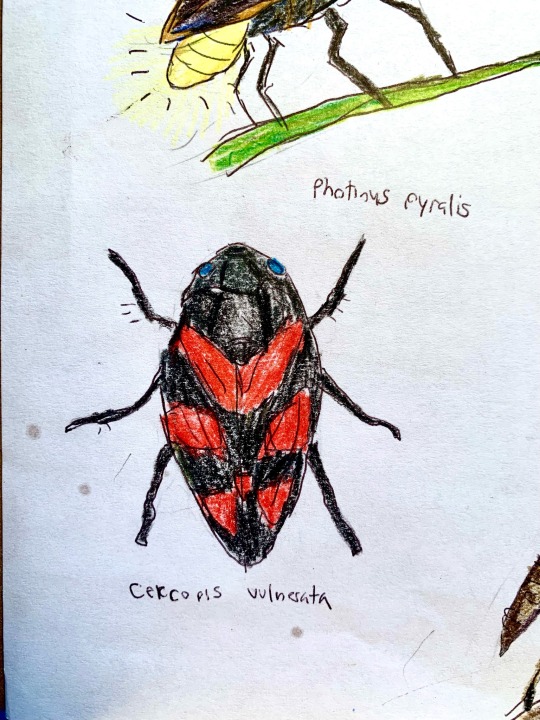
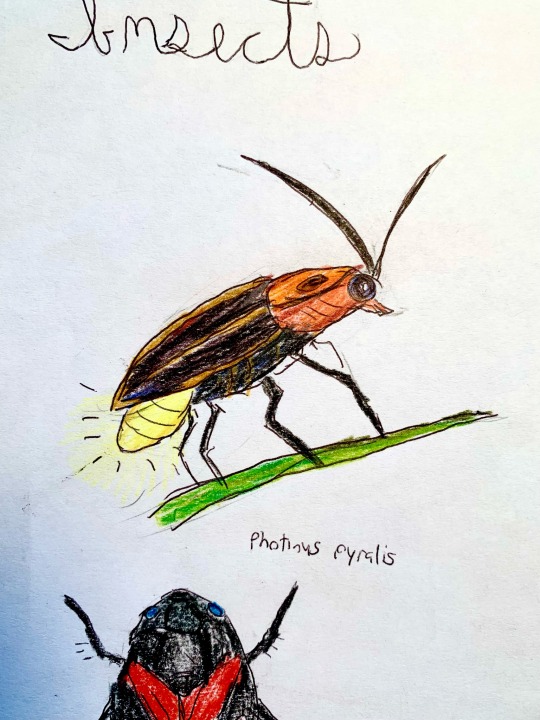



Insects!
Yes, these are all real species. No, I don’t know all their common names. The only one I’ve seen in person is Photinus pyralis, the firefly.
3 notes
·
View notes
Text
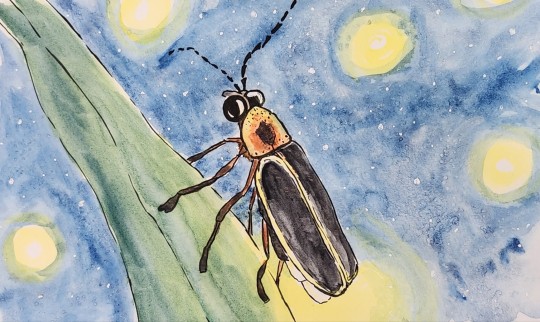
Daily Doodle #0022
Common Eastern Firefly (Photinus pyralis)
@onedoodleaday prompt: Draw something that glows in the dark.
I really need to figure out how to get a smooth wash of color down for the backgrounds. Any large washes I do are always so smudgy.
2 notes
·
View notes
Text

Chapter 3, "A Window Not Missed" - Bruce x Nat -- Available on AO3. Rated M.
Happy Friday! I finally got Chapter 3 of "A Window Not Missed" posted after a couple of weeks of writers' block. Things are already steamy during Bruce and Nat's first "date" at Avengers Tower. Excerpt and link to chapter below!
_____________________________
Bruce sighed and downed the remainder of his drink. “This is a heavy conversation. Fireflies, huh? Tell me about those.”
Natasha smiled and drifted closer after stretching.
Intentional or accidental? Bruce’s mind rushed to analyze, but he told it to calm down. Friends. Just friends.
“Photinus pyralis,” she answered cheekily. “Can I be a science bro now?”
“Haha. Impressive, Romanoff. But you’re way too pretty to be a bro.”
“Hey, pretty girls can be all techy too. Give me one of your programs. Any random one. I bet I can hack it.” She swirled around to face him, eyes narrowing in a glimmering challenge.
Bruce reached around her for the bottle and refilled her glass. His foot brushed over the top of hers along the jade tiled bottom, but the alcohol had slowed his reflex to jump away.
“Drink up, Romanoff. Keep deluding yourself,” he teased.
She fired back with a punch to the arm. It wasn’t a light one, either.
“I mean it. I’m going to show up randomly in your lab one of these days, Banner. You better be ready.”
“Oh, I’ll be ready.” He swallowed a huge gulp, enjoying this hazy feeling way too much. He leaned back and propped both arms along the back wall. Prosecco and the piping hot water had his blood boiling, but in the good kind of way. He was the furthest thing from green, and for a moment he forgot what the other guy could do to her as he tucked a strand of hair behind her ear.
#fanfiction#mcu fic#brutasha#natasha romanoff#bruce banner#brucenat#black widow#hulk#hulkwidow#the avengers
6 notes
·
View notes
Text

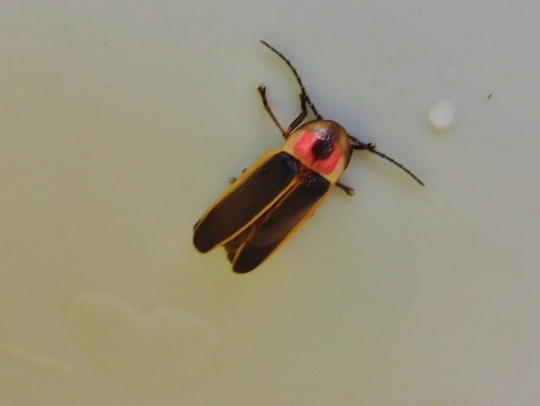
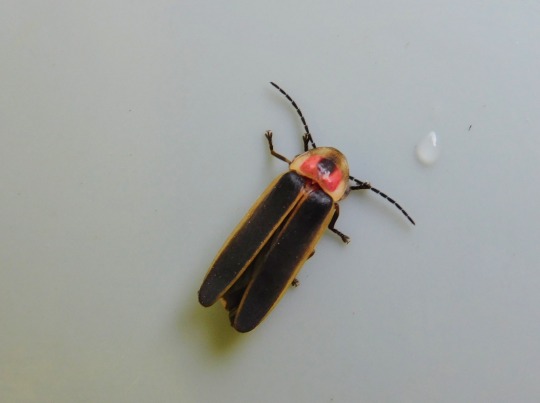
Photinus pyralis - Common Eastern Firefly...
I am speculating these do not taste very good, this specimen was just hanging out on a water bowl shared by assorted wild things and 6 stone-killer Hens...
#nature#my photography#insects#firefly#photinus#backyard nature#nature photography#feedlot#wildlife photography
3 notes
·
View notes
Text
Photinus pyralis
Common Name: Big Dipper Firefly AKA Common Eastern Firefly

Didn't pay my dark bill so the power company shut my lights on
28K notes
·
View notes
Note
Have you done a common eastern firefly? (Photinus pyralis)
Queued!
5 notes
·
View notes
